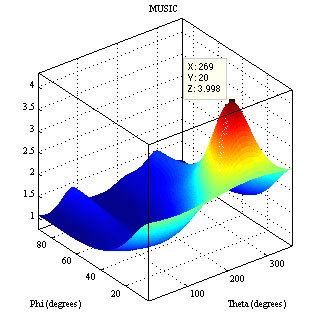Analog and Digital Boards
An analog pre-amplifier and bandpass filter board is fabricated for signal amplification and noise attenuation. Variable gain amplifiers are included to allow for real time adjustment of the input signal. The analog signal is digitally sampled at a rate of 250 kS/s by a custom made data acquisition board (DAQ) featuring the Spartan 6 FPGA. The Raspberry Pi 3B+ receives the input signal and then transmits the Direction of Arrival (DOA) computed with the MUSIC algorithm to the main computer through the UDP protocol.
Algorithm
The incoming ping is first extracted using Short-Time Fourier Transform (STFT) with dynamic thresholding methods that vastly improve the susceptibility of the acoustics system to noise and interfering pings that are not of interest. The extracted Ping is then run through a series of tests, including signal to noise ratio (SnR) and time intervals between pings, to ensure that the extracted ping is not a false positive. The spectrum of the line of sight signal is then obtained, ignoring other parts of the signal that may be affected by multipath reverberation effects.
With that, the spatial covariance matrix is derived, and the eigenvectors corresponding to the signal and noise subspaces are obtained from its eigen-decomposition. The MUSIC algorithm searches for a pair of azimuth and elevation angles where the array steering vector is the most orthogonal to the noise eigenvectors. Hence, the direction of the pinger is indicated by the maximum point of the MUSIC spectrum derived from the 2D search of azimuth and elevation angles, which is done on the Raspberry Pi 3B+.
